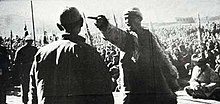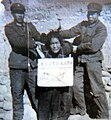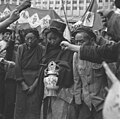Struggle session
This article contains too many pictures for its overall length. |
| Struggle session | ||
|---|---|---|
Lhasa IPA | tʰʌ́msiŋ | |
Struggle sessions (
Struggle sessions were usually conducted at the workplace, classrooms and auditoriums, where "students were pitted against their teachers, friends and spouses were pressured to betray one another, [and] children were manipulated into exposing their parents".[6][9][10] Staging, scripts and agitators were prearranged by the Maoists to incite crowd support.[5][9][10] In particular, the denunciation of prominent "class enemies" was often conducted in public squares and marked by large crowds of people who surrounded the kneeling victim, raised their fists, and shouted accusations of misdeeds.[5][9][10][11]
Etymology
The expression comes from pīpàn (批判, 'to criticize and judge') and dòuzhēng (鬥爭, 'to fight and contest'), so the whole expression conveys the message of "inciting the spirit of judgment and fighting." Instead of saying the full phrase pīpàn dòuzhēng, it was shortened to pīdòu (批鬥).
History
Origins and development

Struggle sessions developed from similar ideas of criticism and
Struggle sessions emerged in China as a tactic to secure the allegiance of the Chinese people during the Land Reform Movement (which ended in 1953).[13] That campaign sought to mobilize the masses through intensive propaganda followed by "speak bitterness" sessions (訴苦, sùkǔ, 'give utterance to grief') in which peasants were encouraged to accuse land owners.[14][15]
The strongest accusations in the speak bitterness sessions were incorporated into scripted and stage-managed public mass accusation meetings (控訴大會, kòngsù dàhuì). Cadres then cemented the peasants' loyalty by inducing them to actively participate in violent acts against landowners. Later struggle sessions were adapted to use outside the CCP as a means of consolidating control of areas under its jurisdiction.[16][17][18]
Cultural Revolution

During the Cultural Revolution (1966–1976), struggle sessions were widely conducted by the Red Guards across mainland China.[3][4][9][10] In the early phase of the revolution (e.g., the "Red August"), mass violence spread over campuses, where teachers and other educators were abusively subjected to frequent struggle sessions, humiliated, and beaten by Red Guards who were their students.[3][4][20] Top officials in the country such as Liu Shaoqi, Peng Dehuai, Tao Zhu were "struggled against" (subjected to "struggle sessions") and persecuted to death during the revolution.[1][2][21][22] According to one source of the classified official statistics, nearly 2 million Chinese were killed and another 125 million were either persecuted or "struggled against" during the Cultural Revolution.[3]
After the Cultural Revolution, struggle sessions were disowned in China starting from the
Gallery
-
A struggle session of a woman in Tibet (1958).
-
The10th Panchen Lama of Tibetduring a struggle session (1964).
-
A struggle session of Marshal Peng Dehuai during the Cultural Revolution (1966). The banner reads "Counter-revolutionary revisionist element Peng Dehuai".
-
A rally to eliminate "Cow demons and snake spirits" during the Cultural Revolution (1966).
-
A struggle session of General Sampho Tsewang Rigzin in Tibet during the Cultural Revolution (1966).
-
A struggle session ofLhasa, Tibetduring the Cultural Revolution (1966).
-
A struggle session of General Sampho Tsewang Rigzin and his wife in Tibet, during the Cultural Revolution (1966).
-
A struggle session of Lu Dingyi, former Vice Premier of China, and Zhou Yang, former Deputy Head of the Publicity Department of CCP, during the Cultural Revolution (1966).
-
A struggle session offirst lady of China and wife of Liu Shaoqi, during the Cultural Revolution(1967).
-
A struggle session ofKhrushchev" who followed "revisionism".
-
A struggle session of Liu Shaoqi held by Uyghur communists. The banner reads "Down with China's Khrushchev!"
-
A struggle session of Liu Shaoqi in Shanghai during the Cultural Revolution (1967).
-
A struggle session of Liu Shaoqi inZhengzhou, Henanduring the Cultural Revolution (1968).
-
A struggle session of Liu Shaoqi during the Cultural Revolution (1968).
-
A struggle session of Liu Shaoqi during the Cultural Revolution (1968).
-
A struggle session of Liu Shaoqi during the Cultural Revolution.
-
A struggle session of General Luo Ruiqing during the Cultural Revolution (1968).
-
A struggle session of Buddhist leader Dechen Chökyi Drönme, a Samding Dorje Phagmo, and her parents during the Cultural Revolution.
-
A struggle session of Buddhist leader Dechen Chökyi Drönme, a Samding Dorje Phagmo, during the Cultural Revolution.
-
A struggle session of Kashopa Chogyal Nyima, a government official in Tibet, during the Cultural Revolution.
Academic studies
Purposes

Frederick T. C. Yu identified three categories of mass campaigns employed by the CCP in the years before and after the establishment of the People's Republic of China (PRC):[28]
- Economic campaigns sought to improve conditions, often by increasing production in particular sectors of the economy.
- Ideological campaigns sought to change people's thinking and behaviour.
- Struggle sessions were similar to ideological campaigns, but "their focus is on the elimination of the power base and/or class position of enemy classes or groups."[29]
The process of struggle sessions served multiple purposes. First, it demonstrated to the masses that the party was determined to subdue any opposition (generally labeled “class enemies”), by violence if necessary. Second, potential rivals were crushed. Third, those who attacked the targeted foes became complicit in the violence and hence invested in the state. All three served to consolidate the party's control, which was deemed necessary because party members constituted a small minority of China's population.[16][17][18]
Both accusation meetings and mass trials were largely propaganda tools to accomplish the party's aims.
Carefully arranged and organized, the mass trials and accusatory meetings followed clear and meticulously prearranged patterns. Dramatic devices such as staging, props, working scripts, agitators, and climactic moments were used to efficiently engage the emotions of the audience—to stir up resentment against the targeted groups and mobilize the audience to support the regime.[30][31]
Accounts
Anne F. Thurston, in Enemies of the People, gave a description of a struggle session for the professor You Xiaoli: "I had many feelings at that struggle session. I thought there were some bad people in the audience. But I also thought there were many ignorant people, people who did not understand what was happening, so I pitied that kind of person. They brought workers and peasants into the meetings, and they could not understand what was happening. But I was also angry."[33]
See also
- Acts of repudiation
- Anti-Bolshevik League incident
- Campaign to Suppress Counterrevolutionaries
- Class warfare
- Futian incident
- Kangaroo court
- Presumption of guilt
- Self-criticism (Marxism–Leninism)
- Show trial
- Two Minutes Hate
References
- ^ a b "Liu Shaoqi (1898-1969)". Chinese University of Hong Kong. Archived from the original on 2018-06-04.
- ^ a b Ramzy, Austin (2016-05-14). "China's Cultural Revolution, Explained". The New York Times. Archived from the original on 2024-01-14.
- ^ a b c d e Song, Yongyi (August 25, 2011). "Chronology of Mass Killings during the Chinese Cultural Revolution (1966–1976)". Sciences Po. Archived from the original on 2024-01-14. Retrieved December 27, 2019.
- ^ The University of Chicago. Archived(PDF) from the original on 2020-04-17.
- ^ a b c Sullivan, Lawrence R. (2011). "Struggle sessions". Historical Dictionary of the Chinese Communist Party. p. 390.
- ^ a b Lu, Xing (2004). "Denunciation rallies". Rhetoric of the Chinese Cultural Revolution: The Impact on Chinese Thought, Culture, and Communication. pp. 140–141.
- ISBN 978-0-7914-0113-2.
- ^ Fang, Jucheng; Jiang, Guinong. "第九章 颠倒乾坤的"文化大革命"" [Chapter 9 The "Cultural Revolution" that turned everything upside down]. People's Net (in Chinese). Archived from the original on 2007-02-21. Retrieved 2021-04-18.
- ^ The University of Chicago.
- ^ The University of Chicago.
- OCLC 18950000.
- ISBN 978-0-8021-1924-7.
- S2CID 142690129.
- JSTOR 24741839.
- ISSN 0009-4633.
- ^ S2CID 144044801.
- ^ OCLC 1014617521.
- ^ S2CID 145444202.
- ISBN 978-1-4422-5172-4.
- The University of Chicago (in Chinese). Archived(PDF) from the original on 2016-10-12.
- JSTOR 2158776.
- ^ Shen, Xiaoyun (2016). "The Sudden Rise and Fall of Tao Zhu, The "Number 4 in Command" in the Cultural Revolution". Modern China Studies (2).
- ISBN 978-0-19-006938-4.
- ISBN 9787010068954. Archived from the originalon 2008-05-11.
- ^ "50 flashbacks signal reform (I)". China Internet Information Center. 2014-10-15. Archived from the original on 2021-11-15. Retrieved 2020-04-29.
- ^ Yu, Guangren. "Dèng Xiǎopíng de qiúshí yù fǎnsī jīngshén" 邓小平的求实与反思精神. Yanhuang Chunqiu (in Chinese). Archived from the original on 2020-05-07. Retrieved 2020-04-29.
- ISBN 9780231110839.
- OCLC 830080345.
- OCLC 2968117. (Summarization of Yu’s categories.)
- OCLC 938707409.
- ^ Also, Strauss, Julia (December 2006). "Morality, Coercion and State Building by Campaign in the Early PRC: Regime Consolidation and After, 1949-1956" (PDF). The China Quarterly. No. 188. pp. 906–908.
- OCLC 690379541.
- ^ "Enemies of the People". World and ischool. June 1987. Archived from the original on 2007-09-30. Retrieved 2011-03-07.









![A struggle session of "San Jia Cun" (Three-Family Village) held by the military (1966), targeting three government officials of Beijing: Deng Tuo, Wu Han, and Liao Mosha.[27]](http://upload.wikimedia.org/wikipedia/commons/thumb/b/b6/1966-10_1966%E5%B9%B4%E5%AF%B9%E4%B8%89%E5%AE%B6%E6%9D%91%E7%9A%84%E6%89%B9%E5%88%A4.jpg/120px-1966-10_1966%E5%B9%B4%E5%AF%B9%E4%B8%89%E5%AE%B6%E6%9D%91%E7%9A%84%E6%89%B9%E5%88%A4.jpg)










